Edible Animal Fat Market Research, 2031
The global edible animal fat market size was valued at $41.8 billion in 2021, and is projected to reach $64.7 billion by 2031, growing at a CAGR of 4.5% from 2022 to 2031.
Edible animal fats include render fats and fish oils. Animal fat mixtures differ significantly from vegetable fat mixtures. The adipose tissue of meat stock is used to produce fat, while a large portion of the fat remains with the meat and is consumed directly with the meat.
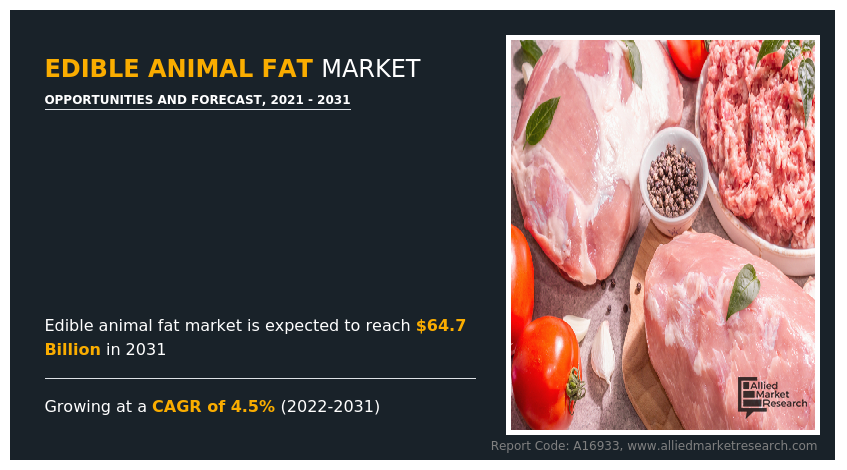
The edible animal fat market is segmented into Application, Type and Source.
Animal fats are high in calories, vitamins, and fatty acids and are considered a healthy source of nutrients. In addition, they aid in the enhancement of food flavor and texture. As a result, many food processors and bakers choose fats such as tallow. Furthermore, animal fats include high levels of oleic acid, which has been linked to a variety of health benefits. Owing to their appealing taste as well as cooking and baking qualities, animal fats such as tallow and lards are chosen during food manufacturing. Tallow, for example, is regarded as a frying ingredient due to its capacity to resist high cooking temperatures while reducing oxidation sensitivity.
Lard, on the other hand, has a soft consistency that makes it a good fat for shortening pastry. As a result, chefs and home cooks prefer animal fats due to their superior flavor and texture. Goose fat and lard are common spreads in France and Germany, whereas tallow is used as French fries in the U.S. Thus, the widespread use of animal fats in the food industry is expected to increase their demand, globally.
The market for animal and marine fats and oils has expanded rapidly due to an increase in demand from downstream industries such as biodiesel, food, oleo chemical, and pet food. Oils and fats are critical raw materials for the production of oleo chemicals such as free fatty acids, methyl esters, fatty alcohols, and amines as well as glycerol as a by-product. Consumers in Asia-Pacific are increasingly preferring lard over butter in baked goods, which is boosting the Edible animal fat Market Demand.
Edible Animal fats provide calories and essential fats as well as aid in the absorption of fat-soluble vitamins such as A, D, E, and K. The type of fat consumed is as important as the total amount of fat consumed for health. That is why it is critical to choose unsaturated fats that are lower in cholesterol. However, overconsumption of unhealthy fats, such as saturated and trans fats, increases low-density lipoprotein (LDL) cholesterol while decrease healthy high-density lipoprotein (HDL) cholesterol. This imbalance increases the risk of high blood pressure, artery hardening (atherosclerosis), heart attack, and stroke. Thus, the increase in the prevalence of health problems as a result of excessive fat and oil consumption hampers the growth of the global market.
Trans-fat is a type of fat that is formed when liquid oils are partially hydrogenated to form solid fats (such as shortening and hard margarine) from their unsaturated fatty acids. However, consumption of trans-fats is associated with an increased risk of cardiovascular disease. In addition, breast cancer, shortening of the pregnancy period, risks of preeclampsia, disorders of the nervous system and vision in infants, colon cancer, diabetes, obesity, and allergies. Thus, alternatives to trans fats have been developed. Hence, consumers are returning to butter, lard, and tallow as fat substitutes in place of trans-fats. As a result, manufacturers are developing various applications of animal and marine fats as substitutes of trans-fat.
Cattle and fish are used as raw materials in the production of animal fats. These animals require a sufficient amount of food as well as demand a level of care. Thus, manufacturers have recognized the importance of this raw material and are attempting to implement various strategies for increased production and cultivation. The animal fats industry is significantly profitable, which has resulted in increase in raw material formulation. As a result, the rapid growth in raw material cultivation and production represents a lucrative opportunity for the Edible animal fat Market Growth.
According to the Edible animal fat Market Analysis, the market is segmented into type, source, application, and region. On the basis of type, the market is categorized into butter, lard, tallows, and others. By source, it is fragmented into cattle, pigs and others. Based on the application, the market is segmented into non-food industry and food industry. The food industry is further bifurcated as bakery and confectionery, savory snacks, and convenience foods. Region wise, it is analyzed across North America (the U.S., Canada, and Mexico), Europe (Russia, Spain, Italy, France, Netherland, Belgium, Germany, the UK, and rest of Europe), Asia-Pacific (China, Japan, Australia, South Korea, India, Thailand, Indonesia, and rest of Asia-Pacific), and LAMEA (Brazil, Argentina, Chile, UAE, Saudi Arabia, South Africa, Algeria, and rest of LAMEA).
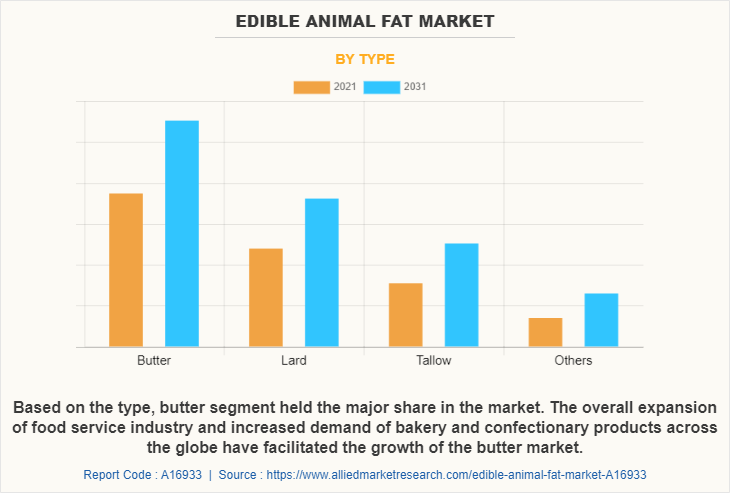
Based on the type, butter segment held the major share in the market. The overall expansion of food service industry and increased demand of bakery and confectionary products across the globe have facilitated the growth of the butter market.
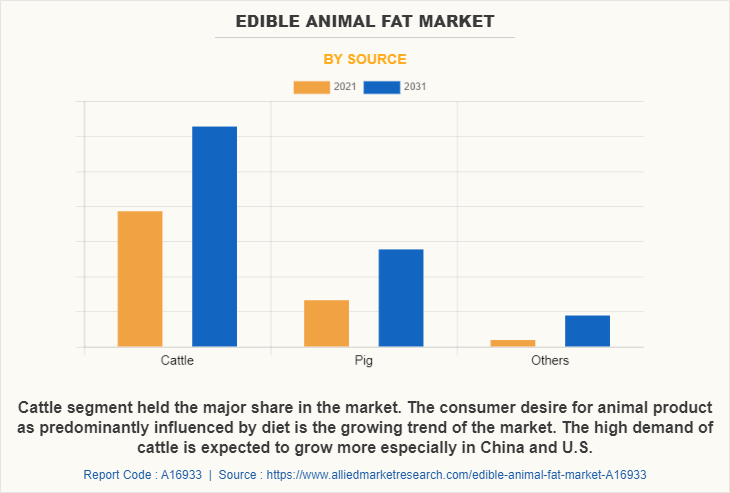
Based on the source, cattle segment held the major share in the market in 2021. The strong disposable income of consumers and barbecue season have pushed the demand of cattle sourced animal fat. The demand factors are very strong and the future holds a discount to the market.
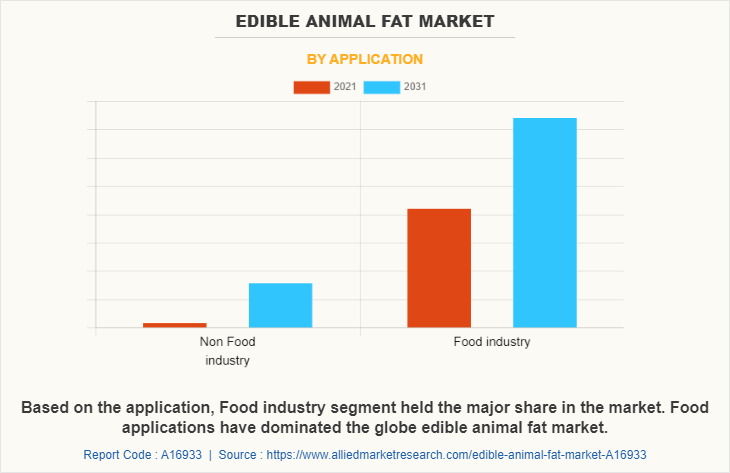
Based on the application, the food industry segment held the major Edible animal fat Market Share in the market. Food applications have dominated the globe edible animal fat market. Butter holds the lion’s share in the food application due to its application in bakery, chocolates, snacks, and desserts. The demand for other animal fats such as tallow, lard, and fish oils have also increased among bakers and other food processors.
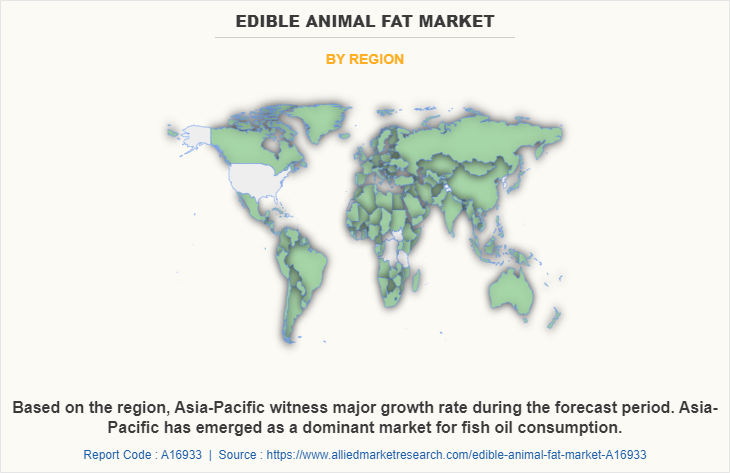
By region, Europe dominates the edible animal fat industry and is likely to remain the same during the Edible animal fat Market Forecast period. The animal feed industry in the region is constantly evolving owing to the growing demand for high-value feed among farmers, which is expected to significantly propel the market growth. An increase in awareness of the health benefits of sustainable animal fat oil, such as fish oil, is expected to boost its consumption across Europe.
The key players in the Edible animal fat Industry include Baker Commodities, Inc., Bunge Limited, COLYER FEHR GROUP, Darling Ingredients, PIERMEN B.V, SARIA A/S GmbH & Co. KG, Ten Kate Holding B.V., York Foods, Sanimax, and BRF.
Key Benefits For Stakeholders
- This report provides a quantitative analysis of the market segments, current trends, estimations, and dynamics of the Edible animal fat Market Size from 2021 to 2031 to identify the prevailing Edible animal fat Market Opportunity.
- The market research is offered along with information related to key drivers, restraints, and opportunities.
- Porter's five forces analysis highlights the potency of buyers and suppliers to enable stakeholders make profit-oriented business decisions and strengthen their supplier-buyer network.
- In-depth analysis of the edible animal fat market segmentation assists to determine the prevailing market opportunities.
- Major countries in each region are mapped according to their revenue contribution to the global market.
- Market player positioning facilitates benchmarking and provides a clear understanding of the present position of the market players.
- The report includes the analysis of the regional as well as global edible animal fat market trends, key players, market segments, application areas, and market growth strategies.
Edible animal fat Market Report Highlights
| Aspects | Details |
| Market Size By 2031 | USD 64.7 billion |
| Growth Rate | CAGR of 4.5% |
| Forecast period | 2021 - 2031 |
| Report Pages | 379 |
| By Application |
|
| By Type |
|
| By Source |
|
| By Region |
|
| Key Market Players | Fats & tallow blends, SARIA A S GmbH and Co. KG, York Foods, Cargill, Incorporated, Sanimax, Bunge Limited, Darling Ingredients, COLYER FEHR GROUP, Ten Kate Holding B.V., PIERMEN B.V, Archer-Daniels Midland Company |
Analyst Review
According to the insights of CXOs of leading companies, animal fats market has witnessed consistent growth in past few years. Moreover, increase in demand for animal fats in F&B industry is one of the key driving factors. The lard obtained by melting animals and tallow obtained from raw fat of other animal species are examples of processed animal fats. Animal fats are primarily used in the production of margarine, shortening, and compound fat. In addition, they are found in many processed foods. Animal fats are used in the manufacturing of soaps, fatty acids, lubricants, and feedstuffs.
The demand from countries, particularly India, China, Malaysia, and Indonesia, drives the market. The demand for edible animal fat is being driven by the respective food sectors of these countries, which are being supported by improvement in living standards and population growth. The growing emphasis on biofuels, such as biodiesel made from animal fats, is driving demand for edible animal fat.
However, health concerns associated with fats and oils are limiting the growth of the global market; for instance, over consumption of these fats and oils increases the risk of thrombosis.
The key players in the market for edible animal fat have been expanding into new markets through acquisitions, new product development, agreements, and certifications. New requirements to label trans-fatty acid levels in foods are putting pressure on manufacturers to use alternative methods for producing hydrogenated oils, thus increasing demand for oils with high trans-fat levels.
increase in preference for oleo chemicals over petrochemicals in the production of soaps, paints, detergents, varnishes, and lubricants are the upcoming trends of Edible animal fat Market in the world.
Food Industry is the leading application of Edible animal fat Market.
Europe is the largest regional market for Edible animal fat.
The global edible animal fat market was valued at $41,800.0 million in 2021, and is projected to reach $64,676.2 million by 2031, registering a CAGR of 4.5%.
The key players in the global edible animal fats industry include Baker Commodities, Inc., Bunge Limited, COLYER FEHR GROUP, Darling Ingredients, PIERMEN B.V, SARIA A/S GmbH & Co. KG, Ten Kate Holding B.V., York Foods, Sanimax, and BRF.
Loading Table Of Content...


